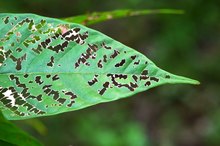The Effects of Air Pollution on Plants
Pollution from car exhaust, factory emissions, fuel combustion and other sources can hang a brown cloud over some cities. Air pollution not only contributes to respiratory diseases in humans and damages buildings, it can also affect plants. The effects of air pollution on plants develop over time and can't be undone 2. Some plants are more susceptible to pollution damage than others according to Fred Davis, a chemist from Kent State University.
Leaf Damage
Chemicals such as sulfur dioxide, ozone, fluorides and peroxyacyl nitrate damage the leaves of plants. If enough leaves are damaged, the entire plant will die. Sulfur dioxide, a by-product of burning fossil fuels such as:
- oil
- coal
- gasoline
- causes changes in the colors of leaf tissue
- which may turn white
- brown or yellow
Slowed Growth
List of Diseases in Plants Caused by Viruses
Learn More
Dr. Kent reports that nitrogen dioxide, a byproduct of combustion from car engines or open fires, can slow the growth of plants. Fortunately, rainfall transforms nitrogen dioxide into nitric acid, which adds nitrogen to the soil and actually benefits plants.
However, carbon monoxide is less benign. This component of car exhaust is poisonous to humans and will stunt the growth of plants. Some evergreens will drop their leaves completely when exposed to carbon monoxide.
- Dr. Kent reports that nitrogen dioxide, a byproduct of combustion from car engines or open fires, can slow the growth of plants.
Insect Infestation
Air pollution weakens plants and makes them more susceptible to insect infestation. The University of Colorado reports that pine trees stressed by air pollution are more susceptible to damage from pine bark beetles 1. A 2008 Newsweek story reported that pine beetles had destroyed 22 million acres of pine trees in Canada and more than 1.5 million acres in Colorado 3.
Related Articles
References
Resources
Writer Bio
Cynthia Myers is the author of numerous novels and her nonfiction work has appeared in publications ranging from "Historic Traveler" to "Texas Highways" to "Medical Practice Management." She has a degree in economics from Sam Houston State University.









